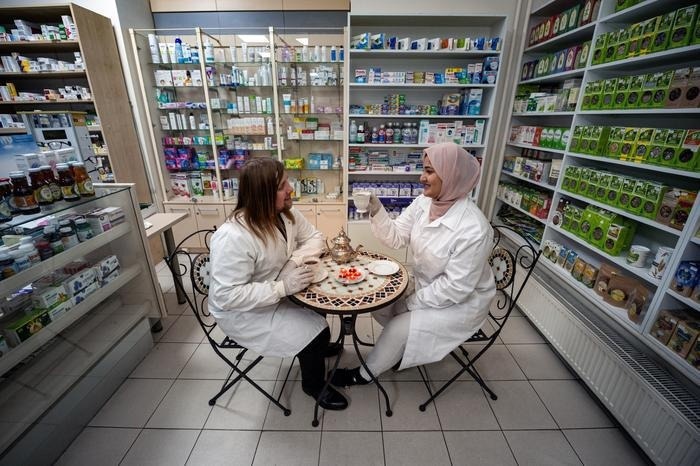There is a pressing need for new methods to tackle antimicrobial-resistant bacteria. Scientists at the Institute of Physical Chemistry of the Polish Academy of Sciences (IPC PAS) recently showcased the potential of green tea-silver nanoparticles in combating pathogens like bacteria and yeast, aiming to devise an effective approach against bacteria unaffected by traditional antimicrobial agents, such as antibiotics.
 Sometimes the simplest visit to the pharmacy can lead to results that surprise even those with a highly developed imagination. Researchers from the IPC PAS have produced nanoparticles that fight pathogens, including drug-resistant bacteria, much more effectively than some antibiotics. Image Credit: Grzegorz Krzyzewski, Lekoteka Pharmacy.
Sometimes the simplest visit to the pharmacy can lead to results that surprise even those with a highly developed imagination. Researchers from the IPC PAS have produced nanoparticles that fight pathogens, including drug-resistant bacteria, much more effectively than some antibiotics. Image Credit: Grzegorz Krzyzewski, Lekoteka Pharmacy.
Since their discovery, antibiotics have reshaped medicine and extended life expectancy, spurring the rapid growth of pharmaceuticals with an array of drugs against various pathogens. However, their overuse has led to a growing global health threat of antibiotic resistance, outpacing the development of new antibiotics and casting doubt on potential solutions. Despite these challenges, there is still an opportunity to overcome this invisible adversary.
A team of scientists from IPC PAS, led by Prof. Jan Paczesny, has been researching innovative nanoformulations to combat widespread pathogens, including the ESKAPE bacteria (Enterococcus faecium, Staphylococcus aureus, Klebsiella pneumoniae, Acinetobacter baumannii, Pseudomonas aeruginosa, and Enterobacter spp.) and yeast pathogens such as Candida auris or Cryptococcus neoformans. These microorganisms quickly develop resistance when treated with commercially available antibiotics.
The scientists targeted the ESKAPE group due to the severe diseases they cause, from sepsis to cancer.
Prof. Paczesny's team, several months ago, combined silver nanoparticles, known for their antimicrobial and antifungal properties, with tea extracts rich in polyphenols, including antioxidants. This approach aimed to enhance broad-spectrum efficacy against pathogens using green hybrid silver nanoparticles (AgNPs), which were more effective than individual components and certain antibiotics.
In their research, the team utilized black tea (B-Tea), green tea (G-Tea), and Pu-erh tea (R-Tea) as capping agents, stabilizing the synthesized particles and preventing aggregation. This method provided a high active surface area compared to other formulations. The eco-friendly synthesis process used natural ingredients, producing structures of varying shapes and sizes, from 34 to 65 nm, depending on the tea type used, and demonstrating distinct reactivity towards microorganisms.
Silver nanoparticles produced with tea extracts (B-TeaNPs, G-TeaNPs, R-TeaNPs) were tested against Gram-negative (E. coli) and Gram-positive (E. faecium) bacterial strains to examine their effect on different cell envelope morphologies. The efficacy was analyzed by comparing outcomes with commercially available antibiotics. The ESKAPE pathogens were then tested for the most effective particle concentration and composition, revealing up to a 25% decrease in bacterial cells in E. faecium and a 90% decrease in E. cloacae.
Additionally, the green silver nanoparticles showed an 80% decrease in viable cells of C. auris and about a 90% decrease for C. neoformans. The antibacterial and antifungal properties of these nanoparticles, due to their high content of phenolic compounds and isoflavonoids like catechins, suggest they could be a prospective way to combat infections and substitute antibiotics in some applications.
The research indicated that antimicrobial hybrid nanoparticles significantly reduced bacteria compared to antibiotics or individual compounds. This major improvement could enable treating superbugs with smaller doses than commercially available compounds, though not all bacteria are destroyed. The low amount of hybrid silver nanoparticles required for overcoming infections makes them cost-effective, functional, and low-cost.
What is more, the size of nanoparticles is usually related to the cytotoxic effect of nanomaterials, with smaller particles being more cytotoxic. This should favor control AgNPs and R-TeaNPs over G-TeaNPs and B-TeaNPs in our experiments. This was not the case. In most experiments, C-AgNPs and R-TeaNPs showed the lowest antimicrobial efficacy. This is in line with other studies, which demonstrated that size is not a primary factor affecting the antimicrobial activity of AgNPs.
Sada Raza, Study First Author, Institute of Physical Chemistry of the Polish Academy of Sciences
This innovative approach could be adapted to combat other challenging bacterial infections. The nanoparticles developed by IPC PAS scientists represent a significant step toward effectively eradicating deadly drug-resistant superbugs, offering an alternative to antibiotics for both Gram-negative and Gram-positive bacteria.
The study highlights the substantial work remaining in this field, showing that compounds used independently are less effective compared to the green hybrid nanoparticles.
We established that silver nanoparticles synthesized with tea extracts have higher antibacterial properties than silver nanoparticles alone. Therefore, lower dosages of TeaNPs could be used (0.1 mg mL−1). We confirmed that in some cases, the synergistic effect of tea extracts and silver nanoparticles allowed for efficacy higher than that of antibiotics (ampicillin) when tested at the same concentrations (0.1 mg mL−1) and after a relatively short exposure time of three hours.
Mateusz Wdowiak, Study Co-Author, Institute of Physical Chemistry of the Polish Academy of Sciences
The main goal was to apply nanoparticles in everyday life, from replacing harmful compounds in agriculture to encouraging organic farming and potentially in biomedical applications, like additives for wound dressings to protect against bacteria. More targeted treatments for drug-resistant superbugs using nanotechnology are in progress.
The investigation was funded by the National Science Centre, Poland, within the SONATA BIS grant number 2017/26/E/ST4/00041 and the Foundation for Polish Science from the European Regional Development Fund within the project POIR.04.04.00-00-14D6/18-00 “Hybrid sensor platforms for integrated photonic systems based on ceramic and polymer materials (HYPHa)” (TEAM-NET program).
Journal Reference:
Raza, S., et al. (2023). Enhancing the antimicrobial activity of silver nanoparticles against ESKAPE bacteria and emerging fungal pathogens by using tea extracts. Nanoscale Advances. doi.org/10.1039/D3NA00220A.